Intel X58 Motherboard Roundup - What does $300 Get You?
by Gary Key on December 5, 2008 3:00 PM EST- Posted in
- Motherboards
Gigabyte GA-EX58-UD5
Features
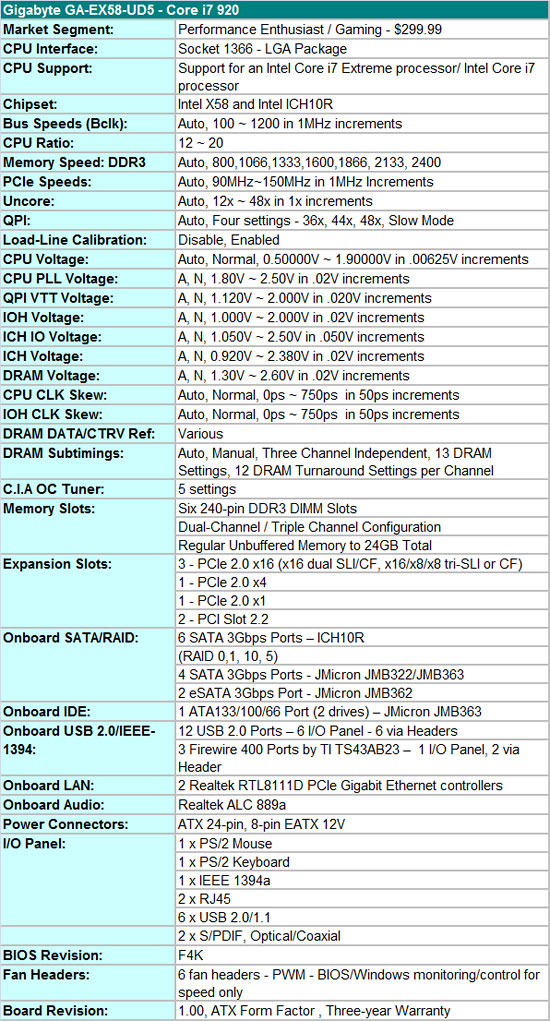
We have to hand it to Gigabyte; if there was an empty spot on the board during the design phase, they figured out a way to add a feature in that space. This board is loaded with everything but the kitchen sink and yet it appears mostly uncluttered; only when using the board do you sometimes notice that it is crowded. Gigabyte throws in twin Realtek RTL-8111D PCIe Gigabit Ethernet controllers that can be teamed; the Realtek ALC-889a is on board for HD audio and features real-time Dolby Digital Live encoding; JMicron’s JMB322/363 chipsets are tabbed for IDE and additional SATA port duties; TI is selected for IEEE 1394a; and the Intel ICH10R is onboard for primary storage purposes.
The BIOS is designed for those who like to tweak for a living. For some, the number of available options will be overwhelming while others will take joy in squeezing out every last little bit the board has to offer. The number of memory timing options is immense and includes the ability to setting timings for each individual channel. However, as we also found with the ASUS board, the auto settings are not always spot on.
Also, the latest beta BIOS we utilized (F4H) has a habit of overriding manual memory settings. This can be a good and bad decision on behalf of the BIOS. The good is that it will do its best to keep the user out of trouble; the bad is that when we manually tweak a board we would like to know when we are in trouble. In the end, the settings determined by the BIOS were always stable and performance was generally not detrimental. We will look at this as a glass half full situation. (update - BIOS F4K received today corrects this problem)
The only nitpick we truly have with the BIOS centers on Load-Line calibration. The purpose of this setting is to reduce VDroop and it works perfectly on the other boards. On our particular board sample we still noticed VDroop when a VCore setting of 1.425V resulted in 1.392V real. Gigabyte is aware of this and is working on it now. Otherwise, we commend Gigabyte for a well laid out BIOS and for offering the enthusiast just about every option one could use on a board.
Gigabyte supports a stock 800MHz ~ 2400MHz memory speed on the i920/i940 processors along with opening up QPI link speeds from a standard 4.800 GT/s up to 6.400 GT/s. They also include a slow mode QPI link speed for high Bclk testing. The board supports up to 24GB of DDR3 memory. We have not had any problems running 12GB of our Patriot or G.Skill DDR3-1600 kits with the latest F4H BIOS. Our final settings are at 1600 with 9-9-9-24 1T timings at 1.66V. Although the timings are looser than the other boards, performance is basically equal; only a user looking for that last bit of advantage in a benchmark would notice a difference.
The three PCI Express 2.0 x16 slots will operate in x16/x16 mode for 2x SLI/CF if the third x16 slot is empty. If you decide to place a PCIe RAID, network, audio, or TV tuner card in the third x16 slot, then the 2x SLI/CF configuration will operate in x16/x8 mode. 3x SLI/CF configurations will run in x16/x8/x8 mode. We had no problems running our ASUS Xonar D2X or Highpoint Rocket RAID cards in x16 slots two or three.
The Board
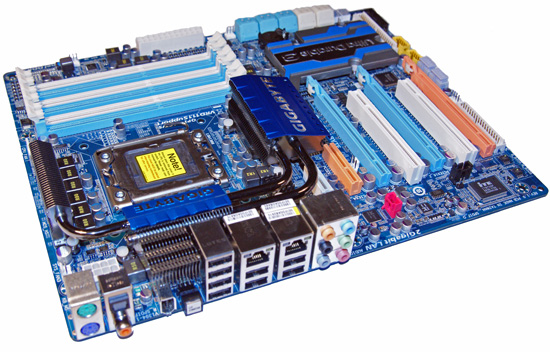
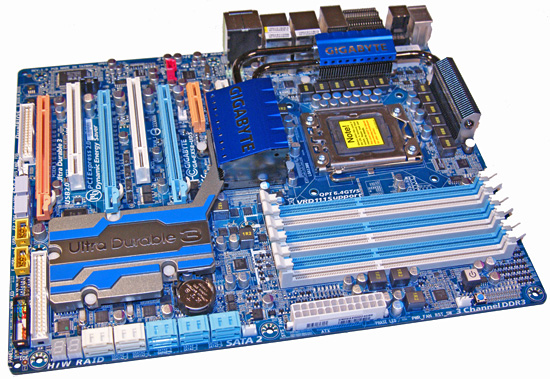
The $299 GA-EX58-UD5 is Gigabyte's mid-range X58 board, with the Extreme version being at the top end with a $330 price tag and the DS4 board placed at the low end with a $245 street price. We think Gigabyte's product separation is right on considering the feature set on each board, although we had hoped the DS4 would also have SLI capability considering the additional cost when compared to the MSI Platinum board.
Gigabyte introduced a new color palette on this board and we like it for the most part. We still notice a few of the crayola colors in use but overall this board would not look bad in a case with a large window. The one item that stands out on the board is the rather large heatsink for the ICH10R/JMicron controllers proudly displaying the Ultra Durable 3 technology incorporated on the board. Ultra Durable 3 refers to Gigabyte's use of solid-state Japanese capacitors, ferrite core chokes, and low RDS(on) MOSFETs along with an extra dose of copper in the board layers.
All of this is meant to improve overclocking potential and extend the life of the board. Until we get to our sub-zero overclocking article, it has been difficult to notice any overclocking differences between this board and the others in our roundup. However, we do appreciate the high quality components that Gigabyte included at this price point.
Gigabyte provides a hefty combination of heatsinks for the northbridge and vrm areas that link together with a heatpipe system. In fact, part of the first VRM heatsink extends into the IO panel to provide an exhaust outlet for the cooling system. Of course this system relies on radial type cooling for proper heat dispersion. We highly recommend direct air-cooling in this area if you are utilizing a tower heatsink/fan for the CPU or water-cooling when overclocking.
The CPU area is fairly open and our larger air coolers installed perfectly without interference from the heatsinks. However, a large air cooler like the Monsoon Vigor III that we utilized will render the first DIMM socket unusable, essentially limiting you to only populating three of the DIMM slots. This board features a two-phase power delivery system for the northbridge and a two-phase delivery for the memory subsystem. A twelve-phase power delivery design is utilized for the processor, which could be construed as overkill, but it does serve its purpose when overclocking. Like the other boards, the capacitors in the CPU area are fairly close to the 1366 socket, something that is important to note when utilizing other cooling methods like large water blocks, cascade, or LN2 setups.
The general layout is very good considering the vast number of ports, slots, and hardware included on the board. Gigabyte's design keeps interference to a minimum with installed peripherals for the most part. The board includes three PCI Express 2.0 x16 slots (x16/x8/x8), one PCIe x1 slot, a single x4 slot, and two PCI slots. This arrangement allows 3X Crossfire or SLI and still leaves the PCIe x1 and x4 slots open. However, using double slot cards for CF or SLI will render the PCI slots physically unusable. It is at this point that we realized a couple of potential problems with this layout.
The first PCIe x1 slot can only be utilized with a half length card, which excludes most audio and tuner cards. The bigger problem is that when utilizing two double slot cards for CF or SLI, the cards sit right next to each other, which inhibits airflow. The same holds true when utilizing the third x16 slot. When installing a dual-slot card in the third slot, it will hangover the board, which could create an installation problem in most cases. We do not care for 3X CF/SLI for general gaming, so we would have preferred a proper dual x16 design or an additional slot between the first two x16 slots to improve cooling or allow water-cooling on the GPUs.
At the rear of the board are the ten SATA ports, a Debug LED display unit, and the IDE connector. The gigantic heatsink covers the ICH10R and the JMB 363/322 controller chipsets. The JMB322s are responsible for the two white SATA ports and offer driver-free RAID 0 and 1 support. The hardware stack in the JMB322 makes arrays appear as standard hard drives and hence the lack of required software drivers when setting them up. Gigabyte took a different approach and hooked the JMB322s directly into JMB363 SATA ports instead of riding on the PCI Express bus as they do on the MSI board. This results in slightly lower performance as our PCMark Vantage HDD test suite will indicate later on. All ten SATA ports have a right angle cable connection scheme that allows them to be utilized even with the longer double-slot video cards. About the only drawback is placing this board in a smaller case where the drive bays would butt up against the board. Even so, we feel this arrangement is the right way to go.
In a change from other board designs, Gigabyte locates the power on and reset buttons behind the DIMM slots, an unusual location but one that we grew accustomed to quickly. At the front of the board Gigabyte places their dual BIOS chips, which can come in handy in case a flash attempt goes south. Also, they figured out a way to include a floppy connector, although we no longer care to see them on boards in this market sector. Gigabyte also throws in some onboard LEDs to light up your life. Actually, they do serve a purpose besides looking cool in a windowed case at night: the LEDs will let you know how many phases are being utilized by the board during operation.
The IO panel features eight USB 2.0 ports, two Ethernet jacks with LED indicators, an IEEE 1394a port, standard PS/2 keyboard/mouse ports, coaxial and optical S/PDIF output ports, and a handy clear CMOS button. The audio panel offers connections to the Realtek ALC 889a HD audio codec. The one thing missing on this board is a fixed eSATA port. However, Gigabyte includes an expansion slot backplate that allows an additional two external SATA ports via any of the board's internal SATA connections.
The Applications
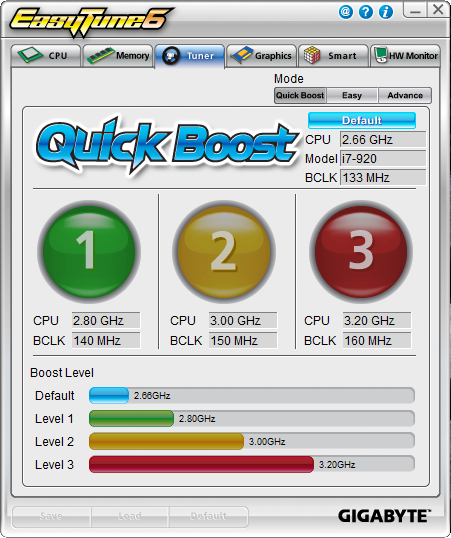
Gigabyte provides their EasyTune 6 application that provides monitoring, system information, and overclocking capabilities. This is one of the best applications provided by the various motherboard suppliers for tuning the system within Windows. We would still like to see the ability to save the settings to the BIOS or at least a BIOS profile; otherwise, this application is useful for extracting a fair amount of performance improvement out of the system within Windows.
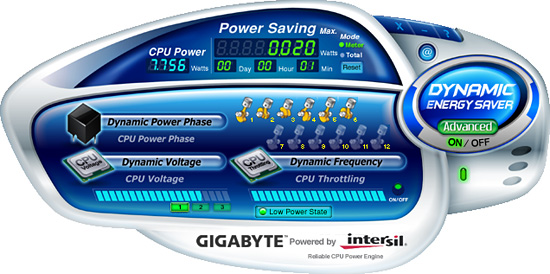
Gigabyte recently updated their DES (Dynamic Energy Saver) software so it is compatible with the X58 chipset, along with providing BIOS improvements. Our original F2 BIOS would not work properly with the latest DES beta but the F4 series has made great strides in this department. We noticed a 5W improvement in idle rates and a 1W improvement in our load tests with DES. Gigabyte expects some additional savings once the software and BIOS are finalized. The DES system offered fast switching times once a full load was placed on the system and we did not experience any crashes during our benchmark tests.






















78 Comments
View All Comments
Elvis2 - Sunday, December 7, 2008 - link
i'm tired of being a free beta tester for these "top" tier manufacturers (remembering my E7205 days). If I'm going to spend $300.+ on a motherboard, I expect it to work AS ADVERTISED. I used to upgrade every year but for the past couple, I've been hesitant to do so. I don't want to fork over my hard earned cash (particularly in this economy)for a new rig only to spend hours on the phone with some tech support guy that dosen't know half of what I do ( let's start on page ten ok?)and wait weeks for a bios that corrects the problem. My Opty rig has been incredibly stable while producing a 50% o/c (thanks eVGA)but is getting long in the tooth. I run SLI and have been waiting on an Intel chipset that supports it. I'm going back to intel and the i7 920...maybe. I'm going to wait a couple of months tho. Bleeding edge, spending that kind of coin, and the hassle of working out the bugs, after fifteen years it's not worth it to me.Sorry for the rant. Jmh $.02.
btw, great article.
fausto412 - Sunday, December 7, 2008 - link
There isn't one board manufacturer thatdoesn't have a bunch of people complaining in the forums all over the internet. Anand's opening explains why.I hate upgrading bios expecting better stability or performance and getting more problems or no fixes.
Gary, i think it is time to have some kinda of database that covers all boards and their known issues going back 2 years or to the 3 series boards. if the flag ship board has a problem then by extension lower end boards have that problem. if they didn't care to make their product the best then that is their problem. GIVE THEM BAD REVIEWS so that they get on the ball.
I never knew Anandtech went back and forward with the board makers as if you're beta testers.
We need to do something to make things better
strikeback03 - Monday, December 8, 2008 - link
I'd argue that it is entirely possible for the flagship product to have problems that lower-end products do not. Expensive X58 is the only option for now for i7 processors, but look back at LGA775. I wouldn't be at all surprised if some stability compromises were made on X38/X48 boards in pursuit of higher SuperPI numbers, while those same compromises are probably not present in the mainstream P35/P45 boards of the same age. Motherboards are one area where I can see going with a mid-level (~$90-130 for LGA775) product might give a better result for the majority of users than jumping to the high end would.borneoo - Sunday, December 7, 2008 - link
Beside the GHz, and MB/s would be good to have a chart/list, which shows the problems of the parts, and aggregated charts to show problems belongs to the same company, ... or SEARCHABLE DATABASE about errors related to products / companies and solutionsJonnyDough - Sunday, December 7, 2008 - link
"Our plan is to cycle through each manufacturer so we are not singling out any one supplier but we are going to be brutally honest in our assessments in these particular focus reviews." (the quote button never works for me in Firefox. Plz fix)Awesome. At least someone is. I think a "two strikes before we post" policy is fair.
DandAG - Sunday, December 7, 2008 - link
After reading the first page of this article “Intel X58 Motherboard Roundup - What does $300 Get You?”, I started reading all the blogs. At first I agreed 100% with Anand’s comments, and wanted to jump on the band wagon like everyone else, but then I read some of the response. Realistically, review sites can’t use the boards under test with ALL the different software/hardware configurations consumers will, and they cannot postpone a review until all the BIOS and operating bugs are fixed…they would be releasing a review a year (or more) after the next generation hardware has already hit the market. People don’t visit these review sites to see how good a DDR2 system is compared to a DDR system, they come to these sites to read about the future, to get the “inside scoop” as to what the manufacturers are thinking up next, and to see the new features of hardware out there today because they are thinking of upgrading right now. To read about overclocking and performance comparisons is really just a bonus for the overwhelming majority. Most people just jump to the conclusion page to see if the reviewer recommends the product or not. We’ve all done it.Review sites need the merchandise to review and the funds to stay afloat, so upsetting certain manufacturers is not in their best interest. They can get away with critiques, questions, “less than expected” reviews, and some (very little) criticisms, but if they were to only give bad reviews every time, manufacturers would stop sending them products to review. And if you think that is a good thing, “they’ll just purchase the final release like the rest of us and provide a balanced review”, think again. If a review site did that, 1) it would have to advertise like crazy to maintain its purchasing ability, 2) not be able to provide future analysis, 3) and not provide the consumer anything more than what “free” chat rooms/manufacturer message boards give you.
I agree there needs to be an industry-wide change; a change in R&D, change in QC, and a change in review process and reporting, BUT the real change has to come from the consumer. We the purchasers of their merchandise have to take a stand, bite the antiquated hardware bullet, and wait to buy until all the bugs are fixed (at least to a reasonable state). As long as we continue to want to be “the first” or “the fastest”, manufacturers will continue to scramble to be first on the market with crap that can or cannot be fixed later on.
Don’t jump down the throats of review sites like AnandTech; instead tell them what YOU want to read about. Give these sites constructive criticism, and suggestions to better themselves like Christoph, Gary, Anand, and all the other reviewers here give the manufacturers. The old “if you don’t have anything better to say, then don’t say anything at all” thing.
Personally, I would love to have AnandTech continue to review the next best thing before it hits the market just to see what the manufacturers are planning and whether or not the reviewer thinks upgrading will be worth it, BUT I also want them to then purchase that same item over-the-counter for a “final look” review, and then tell it like it is. Of course that can’t be done with all items initially reviewed (too time consuming), but the items that bloggers have shown the most interest in.
Steve Z - Sunday, December 7, 2008 - link
First, kudos for reqiring reliability. I've now bought the ASUS board. I won't overclock because I know what gate stress does to CMOS electronics (I slowly destroyed a chip I was testing at an elevated voltage. 18 hours is not enough time to run a $300 CPU). I use my computer to get work done and view overclockability as an indication of robustness in the board's engineering. If it's not - I need to know this. Thank you Gary and Anand - beleive me, $100 extra is a small price to pay for a motherboard that will not waste days of my time trying to get it to work.Second, a notice to those of you who are going to buy the ASUS board. They put the "Crash Free BIOS utility" and the driver installation utility on the same CD. Since installing all the drivers takes 3 restarts, imagine my surprise when installing the ethernet drivers did several surprise BIOS flashes (I didn't even know what was happening at first and I reset the system a few times during the process. To ASUS's credit, the board recovered).
If I pay $300+ dollars for a board, I expect them to pay the extra 5 cents and include a second CD. When you go through your three restarts, make sure you remove the disk every time then put it back in once the OS starts up. Shame on you ASUS for the oversight.
That said, everything is working well now. I hope I didn't buy a product from the company who thought it was only OK for 3 GB to run reliably as I'm running 6 GB now and will go up at some time in the future since I run math sims.
cheers,
--Steve Z.
RagingDragon - Sunday, December 7, 2008 - link
Reading the sections on each board, I think the ASUS was the only board which fully worked, out of the box, with 12GB of RAM. This strongly implies they were *not* the 3GB company.It's hinted the Gigabyte had some undescribed issues with 12GB and older BIOS's, and it's stated that the EVGA also had undescribed issues with 12GB (no indication whether those issues were at stock speeds or when overclocking). The MSI still has issues overclocking 12GB or RAM - nothing said about whether it worked at stock speed out of the box.
LeeKay - Saturday, December 6, 2008 - link
I bought the GA-EX58-Extreme as I posted in the forums the quality of the board is the best I have seen but support wise and bios wise this board sucks worse than any board I have had. For a motherboard to have issues when I use 12GB is beyond me. I want to use this pc for everything from online banking thru gaming for the wife my son and me and to do video editing. Right now I can just run Need for speed undercover at any resonable clock speed without it crashing. Thats as of F4j. And I still can not let my board go to sleep with S3 enabled nor can I expect my Data drives running on the hardware raid controller to recover in S3 mode nore can I run my pc with any of the energy saving options in the bios. Oh and I cannot run my memory at 12gb and at 1600Mhz just noway in hell it will be stable. I have to run it at 1333mhz. I cant run SLI and have my X-FI PCI sound card in either PCI slot and have the pc boot into windows. It just blue screens with the latest Bios. (I am running 2 280GTX with single slot active cooling).The good note is to run at 4.13ghz I am running 1.425v without loadline correction. its stable and with the above taken into account far better tha the past issues.
Sunsmasher - Saturday, December 6, 2008 - link
Your comments are extremely well thought out and relevant.The idea that $300(!) motherboards don't work reliably upon release
is beyond ridiculous.
I think your plan to write an as-is review initially in a great idea.
This will give early buyers a true heads-up on what they're getting.
And then later, you can perform your invaluable beta feedback service to the manufacturers and your readers.
Hopefully, this policy will cause improvements on the QC end.
Thanks again for being so on top of it!